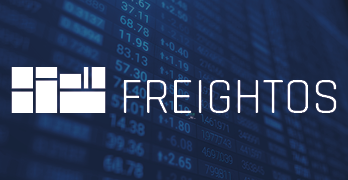FBX Index June 2023: FBX down in May

The Freightos Baltic Global Index (FBX) dipped 11% month on month in May to $1,407/FEU. It is now 9% above 2019 levels, driven by transpacific rates receding from April’s GRI-fueled rise and transatlantic rates continuing their descent.
Transpacific rates to the West Coast fell 23% to $1,309/FEU as they retreated from mid-April GRIs that succeeded in pushing prices up to about $1,700/FEU for the rest of that month. Rates fell on still-sluggish demand and less aggressive capacity management by carriers this month, though at $1,300/FEU, carriers have succeeded in avoiding the sub-$1k/FEU lows seen in March, and rates closed the month 5% higher than in 2019.
Rates to the East Coast did not climb as sharply in April and likewise decreased a more moderate 7% to $2,328/FEU, 83% lower than a year ago and 12% lower than in 2019.
Additional GRIs reportedly planned for June would have to be accompanied by an increase in blank sailings as any climb in volumes is still expected to be moderate at best. At the same time, new low-water level surcharges and weight limits for containers sailing via the Panama Canal starting in June may increase rates to the East Coast and possibly shift some volumes to West Coast destinations as well.
Rates from Asia to N. Europe ticked up 2% this month to $1,420/FEU and are just 4% higher than in 2019. The rumored May GRIs did not materialise on low demand levels and there were no big capacity reductions. 2M are both adding capacity and reducing sailing speeds on this lane, resulting in longer transit times, but no increase in effective capacity.
Asia - Mediterranean prices were stable, decreasing 2% this month to $2,477/FEU, but are still 39% higher than in 2019 as demand has proved resilient on this lane, with some carriers expecting volumes to remain strong through June.
Transatlantic rates decreased 30% in May – after falling 21% in April – to $2,143/FEU. This price is 74% lower than last year and just 6% higher than in 2019. Normalising conditions in terms of demand, congestion and available capacity have finally resulted in rates returning to about pre-pandemic levels on this lane after demand and rates outlasted ex-Asia lanes on a different demand mix and earlier reductions in capacity as transatlantic vessels were shifted to the transpacific during the pandemic surge in ex-Asia volumes.
About Judah Levine, Research Lead, Freightos
Judah is an experienced market research manager, using data-driven analytics to deliver market-based insights. Judah produces the Freightos Group's FBX Weekly Freight Update and other research on what's happening in the industry from shipper behaviors to the latest in logistics technology and digitization.
Receive monthly container market reports direct to your inbox.